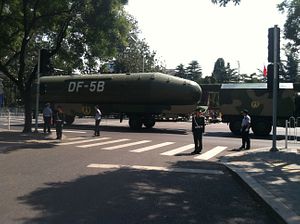The Trump administration has released its missile defense review – a strategic document setting the stage for an expansion of how the U.S. protects its territory, allies and military forces from cruise, ballistic and hypersonic threats. The document’s consequences will range far past just “defence”, however.
As the Nobel Prize-winning game theorist Thomas Schelling once warned, all those decades ago during the cold war, the importance of “feedback” in military planning cannot be overstated. For every action taken by the United States, its adversaries will react. This has been and remains true of missile defence.
It’s why, for instance, last March, Russian President Vladimir Putin stood before the world and unveiled a pantheon of new and exotic nuclear delivery systems.
These weapons were being created “in response to the unilateral withdrawal of the United States of America from the Anti-Ballistic Missile Treaty,” he noted, citing the 2002 decision by the George W. Bush administration to withdraw from the cold war-era treaty.
Russia’s concern was that its nuclear deterrent – the cornerstone of its national security – would be eroded as the U.S. continued to improve its homeland missile defence capabilities. Ultimately, Russia’s ability to hold U.S. targets at risk – a requirement for deterrence – would be gone.
The Trump administration’s missile defence review (MDR) appears to be the harbinger of several actions that will cause reactions ultimately in Moscow and even Beijing that will be to the detriment of global security.
While the new MDR retains the understanding that U.S. homeland missile defence is not directed at the strategic deterrent forces possessed by Russia and China, but at limited threats from North Korea and possibly, one day, Iran, it mentions both countries more so than its predecessor documents.
In Beijing and Moscow, the MDR will be read as a sign that every suspicion about the U.S.’ intentions is true in the end.
China, in particular, with a nuclear force a fraction of the size of what the U.S. possesses, has long been concerned about the possibility that the inexorable march of U.S. missile defence sensors and interceptors will render its deterrent impotent in an actual war.
The concern in Beijing will be that the U.S. might find itself able to disarm China of its nuclear weapons early in a war and “mop up” whatever residual forces China was able to use with its missile defences.
These perceptions are deeply ingrained, even as the ground-based mid-course defence system – the only U.S. missile defence system to exist that has any capability against intercontinental-range ballistic missiles – has a disappointing record of successes in testing.
All of this brings us to the precipice of a potentially destabilising arms race.
Even if U.S. missile defence capabilities leave something to be desired today, Russian and Chinese investments in modernised, new capabilities will be built on the assumption that one day, these capabilities will threaten their deterrent.
Putin showed this last year while China’s development of new technologies, including hypersonic boost-glide vehicles, suggests similar concerns.
For Beijing, should the Trump administration mark the start of a new age of sustained U.S. interest and investment in expansive missile defence capabilities – including possibly the kinds of space-based systems the MDR explicitly discusses – the temptation to expand the size of its nuclear forces will grow as well.
Missile defences, in the end, far from leaving the U.S. safer – or shielded – will create a more dangerous world.
Since the 2002 withdrawal from the Anti-Ballistic Missile Treaty, it has primarily been “rogue” states like North Korea and Iran that motivated the U.S.’ pursuit of a homeland missile defence system.
But more so than ever, the Trump administration has vindicated years of suspicions in Beijing and Moscow that their arsenals won’t be safe for long.
Even though the document is circumspect about the kinds of concerns with Russia and China, it was Trump himself who announced at the launch of the MDR that the U.S. was embarking on a project that would “ensure that we can detect and destroy any missile launched against the United States any time, any place”.
That’s all Russia and China will need to go on to continue their ongoing modernisation efforts.
This article first appeared in the South China Morning Post. It is republished here with kind permission.

































